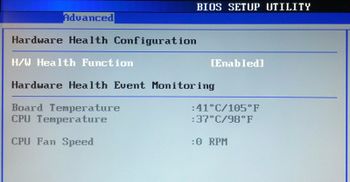Low Energy Server Temperatur Sensoren
| Hinweis: Bitte beachten Sie, dass dieser Artikel / diese Kategorie sich entweder auf ältere Software/Hardware Komponenten bezieht oder aus sonstigen Gründen nicht mehr gewartet wird. Diese Seite wird nicht mehr aktualisiert und ist rein zu Referenzzwecken noch hier im Archiv abrufbar. |
|---|
Der Low Energy Server besitzt zwei Temperatursensoren, die unter Linux mit lm-sensors abgefragt werden können. Das folgende Beispiel zeigt die Verwendung dieser Sensoren unter Ubuntu 12.04 LTS.
Systemvoraussetzungen
- Low Energy Server
- Ubuntu 12.04 LTS
- lm-sensors Paket (installieren per
sudo apt-get install lm-sensors)- Erkennen der Sensoren (siehe Sensoren erkennen)
Sensorausgabe
Das sensors Kommando zeigt die aktuellen Werte der beiden Temperatursensoren:
wfischer@les:~$ sensors acpitz-virtual-0 Adapter: Virtual device temp1: +38.0°C (crit = +105.0°C) coretemp-isa-0000 Adapter: ISA adapter Core 0: +25.0°C (crit = +90.0°C)
| lmsensors Sensor | BIOS Sensor (Advanced -> Hardware Health Configuration) |
Anmerkung |
|---|---|---|
| acpitz-virtual-0 | CPU Temperature | Der Wert für die Obergrenze (im Beispiel +105.0°C) kann im BIOS unter Advanced -> ACPI Settings -> Critical Trip Point (CPU temperature at which the OS shutds down the system) auf folgende Werte eingestellt werden: 80, 85, 90, 95, 100, 105, 110. |
| coretemp-isa-0000 | Board Temperature | Wie im Beispiel oben ersichtlich, interpretiert das sensors Kommando unter Linux den Wert anders als das BIOS. |
Sensoren erkennen
Damit das sensors Kommando die beiden Temperatursensoren findet, müssen die Sensoren mit sudo sensors-detect erkannt werden.
Die letztes Abfrage dieses Kommandos (Do you want to add these lines automatically to /etc/modules? (yes/NO)) kann direkt mit yes beantwortet werden:
wfischer@les:~$ sudo sensors-detect
# sensors-detect revision 5984 (2011-07-10 21:22:53 +0200)
This program will help you determine which kernel modules you need
to load to use lm_sensors most effectively. It is generally safe
and recommended to accept the default answers to all questions,
unless you know what you're doing.
Some south bridges, CPUs or memory controllers contain embedded sensors.
Do you want to scan for them? This is totally safe. (YES/no):
Module cpuid loaded successfully.
Silicon Integrated Systems SIS5595... No
VIA VT82C686 Integrated Sensors... No
VIA VT8231 Integrated Sensors... No
AMD K8 thermal sensors... No
AMD Family 10h thermal sensors... No
AMD Family 11h thermal sensors... No
AMD Family 12h and 14h thermal sensors... No
AMD Family 15h thermal sensors... No
AMD Family 15h power sensors... No
Intel digital thermal sensor... Success!
(driver `coretemp')
Intel AMB FB-DIMM thermal sensor... No
VIA C7 thermal sensor... No
VIA Nano thermal sensor... No
Some Super I/O chips contain embedded sensors. We have to write to
standard I/O ports to probe them. This is usually safe.
Do you want to scan for Super I/O sensors? (YES/no):
Probing for Super-I/O at 0x2e/0x2f
Trying family `National Semiconductor/ITE'... No
Trying family `SMSC'... No
Trying family `VIA/Winbond/Nuvoton/Fintek'... No
Trying family `ITE'... No
Probing for Super-I/O at 0x4e/0x4f
Trying family `National Semiconductor/ITE'... No
Trying family `SMSC'... No
Trying family `VIA/Winbond/Nuvoton/Fintek'... No
Trying family `ITE'... No
Some systems (mainly servers) implement IPMI, a set of common interfaces
through which system health data may be retrieved, amongst other things.
We first try to get the information from SMBIOS. If we don't find it
there, we have to read from arbitrary I/O ports to probe for such
interfaces. This is normally safe. Do you want to scan for IPMI
interfaces? (YES/no):
Probing for `IPMI BMC KCS' at 0xca0... No
Probing for `IPMI BMC SMIC' at 0xca8... No
Some hardware monitoring chips are accessible through the ISA I/O ports.
We have to write to arbitrary I/O ports to probe them. This is usually
safe though. Yes, you do have ISA I/O ports even if you do not have any
ISA slots! Do you want to scan the ISA I/O ports? (YES/no):
Probing for `National Semiconductor LM78' at 0x290... No
Probing for `National Semiconductor LM79' at 0x290... No
Probing for `Winbond W83781D' at 0x290... No
Probing for `Winbond W83782D' at 0x290... No
Lastly, we can probe the I2C/SMBus adapters for connected hardware
monitoring devices. This is the most risky part, and while it works
reasonably well on most systems, it has been reported to cause trouble
on some systems.
Do you want to probe the I2C/SMBus adapters now? (YES/no):
Using driver `i2c-isch' for device 0000:00:1f.0: Intel SCH
Module i2c-dev loaded successfully.
Next adapter: intel drm LVDSBLC_B (i2c-0)
Do you want to scan it? (YES/no/selectively):
Next adapter: intel drm LVDSDDC_C (i2c-1)
Do you want to scan it? (YES/no/selectively):
Client found at address 0x50
Probing for `Analog Devices ADM1033'... No
Probing for `Analog Devices ADM1034'... No
Probing for `SPD EEPROM'... No
Probing for `EDID EEPROM'... No
Client found at address 0x51
Probing for `Analog Devices ADM1033'... No
Probing for `Analog Devices ADM1034'... No
Probing for `SPD EEPROM'... No
Client found at address 0x52
Probing for `Analog Devices ADM1033'... No
Probing for `Analog Devices ADM1034'... No
Probing for `SPD EEPROM'... No
Client found at address 0x53
Probing for `Analog Devices ADM1033'... No
Probing for `Analog Devices ADM1034'... No
Probing for `SPD EEPROM'... No
Next adapter: intel drm SDVOCTRL_ (i2c-2)
Do you want to scan it? (YES/no/selectively):
Now follows a summary of the probes I have just done.
Just press ENTER to continue:
Driver `coretemp':
* Chip `Intel digital thermal sensor' (confidence: 9)
To load everything that is needed, add this to /etc/modules:
#----cut here----
# Chip drivers
coretemp
#----cut here----
If you have some drivers built into your kernel, the list above will
contain too many modules. Skip the appropriate ones!
Do you want to add these lines automatically to /etc/modules? (yes/NO)yes
Successful!
Monitoring programs won't work until the needed modules are
loaded. You may want to run 'service module-init-tools start'
to load them.
Unloading i2c-dev... OK
Unloading cpuid... OK
wfischer@les:~$
Weitere Informationen
- Kernel driver coretemp (git.kernel.org, Dokumentation zu Kernel 3.2)
|
Autor: Werner Fischer Werner Fischer arbeitet im Product Management Team von Thomas-Krenn. Er evaluiert dabei neueste Technologien und teilt sein Wissen in Fachartikeln, bei Konferenzen und im Thomas-Krenn Wiki. Bereits 2005 - ein Jahr nach seinem Abschluss des Studiums zu Computer- und Mediensicherheit an der FH Hagenberg - heuerte er beim bayerischen Server-Hersteller an. Als Öffi-Fan nutzt er gerne Bus & Bahn und genießt seinen morgendlichen Spaziergang ins Büro.
|


